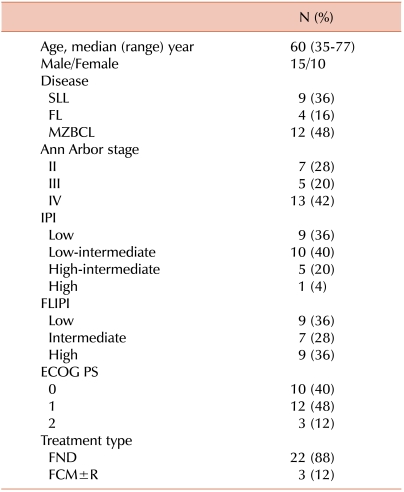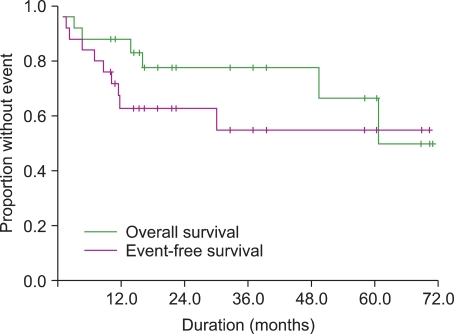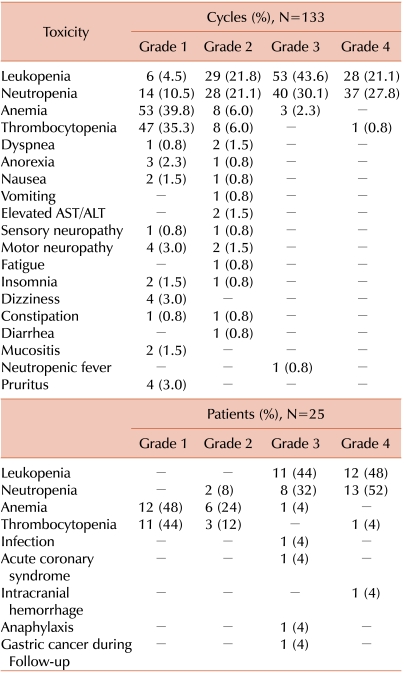1. Portlock CS. Management of the low-grade non-Hodgkin's lymphomas. Semin Oncol. 1990; 17:51–59. PMID:
2406918.
2. Berger F, Felman P, Sonet A, et al. Nonfollicular small B-cell lymphomas: a heterogeneous group of patients with distinct clinical features and outcome. Blood. 1994; 83:2829–2835. PMID:
8180379.

3. Ardeshna KM, Smith P, Norton A, et al. Long-term effect of a watch and wait policy versus immediate systemic treatment for asymptomatic advanced-stage non-Hodgkin lymphoma: a randomised controlled trial. Lancet. 2003; 362:516–522. PMID:
12932382.

4. Armitage JO. Staging non-Hodgkin lymphoma. CA Cancer J Clin. 2005; 55:368–376. PMID:
16282281.

5. Luthy SK, Ng AK, Silver B, et al. Response to low-dose involved-field radiotherapy in patients with non-Hodgkin's lymphoma. Ann Oncol. 2008; 19:2043–2047. PMID:
18647962.

6. Berger F, Felman P, Thieblemont C, et al. Non-MALT marginal zone B-cell lymphomas: a description of clinical presentation and outcome in 124 patients. Blood. 2000; 95:1950–1956. PMID:
10706860.

7. Oh SY, Ryoo BY, Kim WS, et al. Nongastric marginal zone B-cell lymphoma: analysis of 247 cases. Am J Hematol. 2007; 82:446–452. PMID:
17266060.

8. Dana BW, Dahlberg S, Nathwani BN, et al. Long-term follow-up of patients with low-grade malignant lymphomas treated with doxorubicin-based chemotherapy or chemoimmunotherapy. J Clin Oncol. 1993; 11:644–651. PMID:
8478660.

9. Brandt L, Kimby E, Nygren P, et al. A systematic overview of chemotherapy effects in indolent non-Hodgkin's lymphoma. Acta Oncol. 2001; 40:213–223. PMID:
11441933.

10. Klasa RJ, Meyer RM, Shustik C, et al. Randomized phase III study of fludarabine phosphate versus cyclophosphamide, vincristine, and prednisone in patients with recurrent low-grade non-Hodgkin's lymphoma previously treated with an alkylating agent or alkylator-containing regimen. J Clin Oncol. 2002; 20:4649–4654. PMID:
12488409.

11. Bellosillo B, Villamor N, Colomer D, Pons G, Montserrat E, Gil J. In vitro evaluation of fludarabine in combination with cyclophosphamide and/or mitoxantrone in B-cell chronic lymphocytic leukemia. Blood. 1999; 94:2836–2843. PMID:
10515887.

12. Furlan A, Villanova F, Pietrogrande F, Celadin M, Sanzari M, Vianello F. Low-dose fludarabine increases rituximab cytotoxicity in B-CLL cells by triggering caspases activation in vitro. Leuk Lymphoma. 2010; 51:107–113. PMID:
20001234.
13. Flinn IW, Neuberg DS, Grever MR, et al. Phase III trial of fludarabine plus cyclophosphamide compared with fludarabine for patients with previously untreated chronic lymphocytic leukemia: US Intergroup Trial E2997. J Clin Oncol. 2007; 25:793–798. PMID:
17283364.
14. Fabbri A, Lenoci M, Gozzetti A, et al. Low-dose oral fludarabine plus cyclophosphamide as first-line treatment in elderly patients with indolent non-Hodgkin lymphoma. Br J Haematol. 2007; 139:90–93. PMID:
17854311.

15. Ferrario A, Merli F, Luminari S, et al. Phase II fludarabine and cyclophosphamide for the treatment of indolent B cell non-follicular lymphomas: final results of the LL02 trial of the Gruppo Italiano per lo Studio dei Linfomi (GISL). Ann Hematol. 2011; 90:323–330. PMID:
20848104.
16. Tam CS, Wolf M, Prince HM, et al. Fludarabine, cyclophosphamide, and rituximab for the treatment of patients with chronic lymphocytic leukemia or indolent non-Hodgkin lymphoma. Cancer. 2006; 106:2412–2420. PMID:
16649223.

17. Brown JR, Friedberg JW, Feng Y, et al. A phase 2 study of concurrent fludarabine and rituximab for the treatment of marginal zone lymphomas. Br J Haematol. 2009; 145:741–748. PMID:
19344412.

18. Zinzani PL, Pulsoni A, Perrotti A, et al. Fludarabine plus mitoxantrone with and without rituximab versus CHOP with and without rituximab as front-line treatment for patients with follicular lymphoma. J Clin Oncol. 2004; 22:2654–2661. PMID:
15159414.

19. Zinzani PL, Pulsoni A, Gentilini P, et al. Effectiveness of fludarabine, idarubicin and cyclophosphamide (FLUIC) combination regimen for young patients with untreated nonfollicular low-grade non-Hodgkin's lymphoma. Leuk Lymphoma. 2004; 45:1815–1819. PMID:
15223641.

20. Peinert S, Carney D, Prince HM, Januszewicz EH, Seymour JF. Fludarabine combinations for patients with advanced marginal zone lymphomas--best treatment option or too toxic? Br J Haematol. 2009; 146:685–686. PMID:
19638019.
21. Cheson BD, Pfistner B, Juweid ME, et al. Revised response criteria for malignant lymphoma. J Clin Oncol. 2007; 25:579–586. PMID:
17242396.
22. Hagenbeek A, Eghbali H, Monfardini S, et al. Phase III intergroup study of fludarabine phosphate compared with cyclophosphamide, vincristine, and prednisone chemotherapy in newly diagnosed patients with stage III and IV low-grade malignant Non-Hodgkin's lymphoma. J Clin Oncol. 2006; 24:1590–1596. PMID:
16575010.

23. Velasquez WS, Lew D, Grogan TM, et al. Combination of fludarabine and mitoxantrone in untreated stages III and IV low-grade lymphoma: S9501. J Clin Oncol. 2003; 21:1996–2003. PMID:
12743154.

24. Dimopoulos MA, Fountzilas G, Papageorgiou E, et al. Primary treatment of low-grade non-Hodgkin's lymphoma with the combination of fludarabine and mitoxantrone: a phase II study of the Hellenic Cooperative Oncology Group. Leuk Lymphoma. 2002; 43:111–114. PMID:
11908713.

25. Lazzarino M, Orlandi E, Montillo M, et al. Fludarabine, cyclophosphamide, and dexamethasone (FluCyD) combination is effective in pretreated low-grade non-Hodgkin's lymphoma. Ann Oncol. 1999; 10:59–64. PMID:
10076723.

26. Zinzani PL, Magagnoli M, Bendandi M, et al. Efficacy of fludarabine and mitoxantrone (FN) combination regimen in untreated indolent non-Hodgkin's lymphomas. Ann Oncol. 2000; 11:363–365. PMID:
10811507.

27. Tobinai K, Watanabe T, Ogura M, et al. Phase II study of oral fludarabine phosphate in relapsed indolent B-Cell non-Hodgkin's lymphoma. J Clin Oncol. 2006; 24:174–180. PMID:
16330664.

28. Tobinai K, Ishizawa K, Ogura M, et al. Phase II study of oral fludarabine in combination with rituximab for relapsed indolent B-cell non-Hodgkin lymphoma. Cancer Sci. 2009; 100:1951–1956. PMID:
19594547.






 PDF
PDF ePub
ePub Citation
Citation Print
Print





 XML Download
XML Download